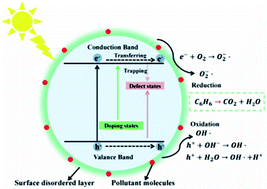Our official English website, www.x-mol.net, welcomes your feedback! (Note: you will need to create a separate account there.)
Mechanistic study of N–H- and H–N-codoping of a TiO2 photocatalyst for efficient degradation of benzene under visible light
RSC Advances ( IF 3.9 ) Pub Date : 2020-1-15 , DOI: 10.1039/c9ra09661b Minghui Li 1, 2 , Wulin Song 1, 2 , Lei Zeng 1 , Dawen Zeng 1 , Changsheng Xie 1 , Qun Yang 3
RSC Advances ( IF 3.9 ) Pub Date : 2020-1-15 , DOI: 10.1039/c9ra09661b Minghui Li 1, 2 , Wulin Song 1, 2 , Lei Zeng 1 , Dawen Zeng 1 , Changsheng Xie 1 , Qun Yang 3
Affiliation

|
Non-metal codoping including nitrogen (N) and hydrogen (H) codoping has been emerging as an effective way to improve the performance of anatase TiO2 in solar cell, fuel conversion and pollutant degradation. However, the mechanism of the synergistic effect of N doping and H doping on TiO2 is still far from thorough. In this paper, N and H codoped TiO2 nanoparticles are obtained by N doping in ammonia and then H doping in hydrogen gas, which achieves substantially boosted efficiency and reaction rate in the photocatalytic degradation of benzene under visible light excitation. The superiority of the N–H–TiO2 photocatalyst was fully elaborated by comparing with H–N–TiO2, which was obtained by thermal treating in H2 and then NH3. The reaction rate of N–H–TiO2 in the photocatalytic degradation of benzene was nearly 2 times that of H–N–TiO2, ∼7 times higher than that of pristine TiO2. Furthermore, the cycling test revealed the high repeatability and stability of the N–H–TiO2 photocatalyst. The excellent performance N–H–TiO2 was attributed to an adequate concentration of NiHi defects occupying interstitial sites of the TiO2 structure and a disordered surface layer introduced by annealing in NH3 and H2 successively. The synergistic effect of N–H-codoping also increased the separation and migration of electron–hole pairs triggering a photoinduced redox reaction on the surface of TiO2.
中文翻译:

TiO2光催化剂的N-H-和H-N-共掺杂在可见光下有效降解苯的机理研究
包括氮(N)和氢(H)共掺杂在内的非金属共掺杂已成为提高锐钛矿TiO 2在太阳能电池、燃料转化和污染物降解中的性能的有效途径。然而,N掺杂和H掺杂对TiO 2的协同作用机理还远未完全。在本文中,N和H共掺杂的TiO 2纳米颗粒是通过在氨中掺杂N,然后在氢气中掺杂H,在可见光激发下显着提高苯的光催化降解效率和反应速率。通过与H-N-TiO 2的比较,充分阐述了N-H-TiO 2光催化剂的优越性, 它是通过在 H 2和 NH 3中热处理获得的。N-H-TiO 2在光催化降解苯中的反应速率是H-N-TiO 2的近 2 倍,是原始 TiO 2的 7 倍。此外,循环测试揭示了 N-H-TiO 2光催化剂的高重复性和稳定性。N-H-TiO 2的优异性能归因于足够浓度的 N i H i缺陷占据 TiO 2结构的间隙位点以及通过在 NH 3和 H 2中退火引入的无序表面层依次。N-H-共掺杂的协同效应也增加了电子-空穴对的分离和迁移,从而引发了TiO 2表面的光致氧化还原反应。
更新日期:2020-01-15
中文翻译:

TiO2光催化剂的N-H-和H-N-共掺杂在可见光下有效降解苯的机理研究
包括氮(N)和氢(H)共掺杂在内的非金属共掺杂已成为提高锐钛矿TiO 2在太阳能电池、燃料转化和污染物降解中的性能的有效途径。然而,N掺杂和H掺杂对TiO 2的协同作用机理还远未完全。在本文中,N和H共掺杂的TiO 2纳米颗粒是通过在氨中掺杂N,然后在氢气中掺杂H,在可见光激发下显着提高苯的光催化降解效率和反应速率。通过与H-N-TiO 2的比较,充分阐述了N-H-TiO 2光催化剂的优越性, 它是通过在 H 2和 NH 3中热处理获得的。N-H-TiO 2在光催化降解苯中的反应速率是H-N-TiO 2的近 2 倍,是原始 TiO 2的 7 倍。此外,循环测试揭示了 N-H-TiO 2光催化剂的高重复性和稳定性。N-H-TiO 2的优异性能归因于足够浓度的 N i H i缺陷占据 TiO 2结构的间隙位点以及通过在 NH 3和 H 2中退火引入的无序表面层依次。N-H-共掺杂的协同效应也增加了电子-空穴对的分离和迁移,从而引发了TiO 2表面的光致氧化还原反应。

























 京公网安备 11010802027423号
京公网安备 11010802027423号